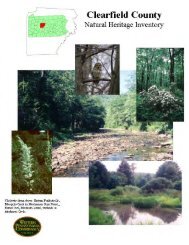Pike CNHI - Pennsylvania Natural Heritage Program
Pike CNHI - Pennsylvania Natural Heritage Program
Pike CNHI - Pennsylvania Natural Heritage Program
Create successful ePaper yourself
Turn your PDF publications into a flip-book with our unique Google optimized e-Paper software.
Another inhabitant of these well drained areas is the woodland vole (Microtus pinetorum), a common species<br />
which lives in cool forests with rocky substrates and an abundance of mosses and ferns.<br />
The forested tracts of <strong>Pike</strong> County are also important<br />
habitat for the region’s mammals. The gray fox (Urocyon<br />
cinereoargenteus) is primarily a denizen of forests,<br />
though it may also be found foraging in more open<br />
habitats. This native fox is known to be an adept tree<br />
climber and feeds on rabbits and other small mammals.<br />
Snowshoe hares (Lepus americanus) roam throughout<br />
portions of <strong>Pike</strong> County, but changes in habitat and<br />
competition with deer for food have caused declines of<br />
this species. Forested habitats are also important for the<br />
native deer mouse (Peromyscus maniculatus), a very<br />
important species to the ecology of <strong>Pennsylvania</strong>’s Hairy-tailed mole (Parascalops breweri)<br />
ecosystems, being a main food source for a host of other vertebrates. The porcupine (Erethizon dorsatum) is<br />
often persecuted for the damage they can do to wooden structures and trees. While they may eventually kill<br />
some trees, it is important to note that the trees killed by porcupines may serve as important habitat for a mix of<br />
other species.<br />
Also living in forested habitats is the woodland jumping mouse (Napaeozapus insignis) and the southern redbacked<br />
vole (Clethrionomys gapperi), both of which serve as an important food source for many other<br />
mammals, as well as birds of prey. The masked shrew (Sorex cinereus) and smoky shrew (S. fumeus) are<br />
found in a number of different habitats, but tend to prefer cool, moist forests and woodlands. These shrews<br />
can also be found close to waterways where insect<br />
populations, the major food source for these species,<br />
are healthy. The northern water shrew (S. palustris<br />
albibarbis), a species of concern in <strong>Pennsylvania</strong>, is<br />
also found along cool mountain streams where it<br />
actually dives to capture invertebrate prey on the<br />
bottom of these waterways. Pygmy shrews (S. hoyi)<br />
are the smallest mammals in North America, and one<br />
of the smallest in the world. About the weight of a<br />
dime, pygmy shrews live under logs and stumps in<br />
Woodland jumping mouse (Napaeozapus insignis)<br />
Charlie Eichelberger, PNHP<br />
many of the states forests, from low wet areas to upper<br />
elevation dryer habitats. The rock shrew (S. dispar), as<br />
the name implies, can be found living on rocky slopes<br />
or along waterways with subterranean rocky retreats.<br />
Not collected in <strong>Pike</strong> County, the species likely exists since ample habitat is available and the species has<br />
been captured in some of the surrounding counties.<br />
Favoring conifer patches, the red squirrel (Tamiasciurus hudsonicus) is much smaller than the more common<br />
widespread gray squirrel. Though much smaller than it’s larger gray cousin, the red squirrel is highly<br />
territorial, and its loud staccato “cherr” is used to fend off potential predators. The nocturnal southern flying<br />
squirrel (Glaucomys volans) is also known from <strong>Pike</strong> County, living in mixed forests with adequate tree<br />
cavities, in which they nest. The northern flying squirrel (G. sabrinus), a state endangered species, is<br />
specialized to live in conifer forests and two populations are known from <strong>Pike</strong> County.<br />
Bats are becoming increasingly rare in <strong>Pike</strong> County, due in large part to the devastating White-Nose Syndrome<br />
(WNS). Bats can be encountered during the summer months along the streams and open bodies of water. The<br />
little brown bat (Myotis lucifugus), big brown bat (Eptesicus fuscus), northern myotis (M. septentrionalis), and<br />
tricolored bat (Perimyotis subflavus) spend the active season foraging along waterways and rearing young in<br />
<strong>Pike</strong> County <strong>Natural</strong> <strong>Heritage</strong> Inventory – Animals of <strong>Pike</strong> County / 23<br />
Charlie Eichelberger, PNHP










